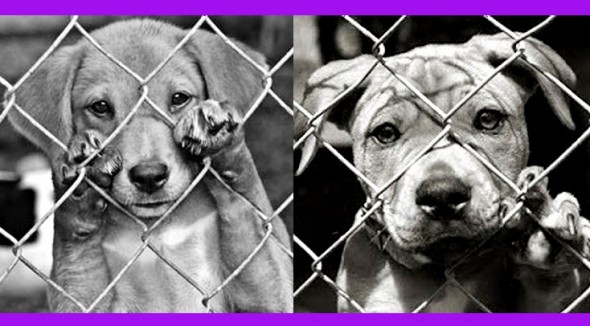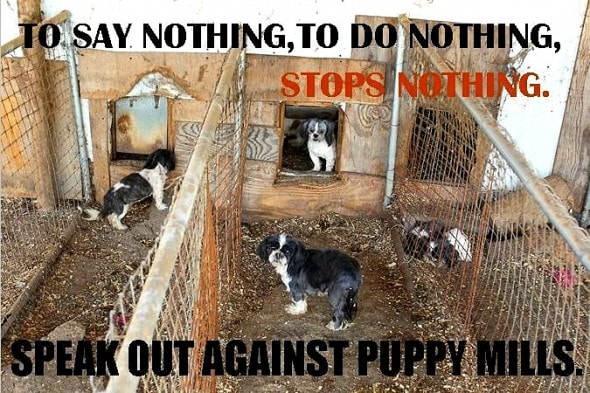Just what is a puppy mill?
A puppy mill is . . . .
The dilemma
Twenty years ago, people knew that a "puppy mill" was a substandard kennel where unhealthy, overbred dogs were kept in horrendous conditions.
Today it's not so easy. In the last decade of the 20th Century, activist groups began to broaden the term to cover just about any kennel that they didn't like. As a result, commercial kennels and hobby breeders with more than an arbitrary number of dogs or litters have become targets for anti-breeding groups that lobby for laws to restrict these law-abiding operations. These organizations stir up public support for breeding restrictions and high license fees by deliberately blurring the lines between responsible breeding operations and real puppy mills. They use emotional rhetoric and pictures of dirty kennels and sickly dogs to imply that most or all breeders will subject their dogs to abusive lives unless they are regulated.
Shelter and rescue workers who receive dogs from raids on squalid kennels often lead the fight for laws restricting or regulating breeding in an effort to close kennels they label as puppy mills. Some responsible breeders are so incensed at the existence of substandard kennels that they are willing to accept these punitive licensing schemes even though the costs may limit or destroy their breeding programs.
Lawmakers who write bills aimed at preventing puppy mills leave the definitions up to those who lobby for the laws. As a result, publicity campaigns highlight kennels where dozens or hundreds of dogs are kept in poor conditions, but the bills themselves often target responsible hobby and commercial breeders with far fewer breeding dogs.
So, how do we evaluate those bills and make sure that substandard kennels are cleaned up? First we have to define "puppy mill." Is it . . .
- A dirty, trashy place where one or several breeds of dogs are kept in deplorable conditions with little or no medical care and puppies are always available?
- Any high-volume kennel?
- A clean place where several breeds of dogs are raised in adequate conditions and the breeder usually or always has puppies for sale?
- A place where a single breed of dog is raised in acceptable conditions and puppies are usually or often available?
- A place where lots of dogs are raised, where breeding is done solely for financial gain rather than protection of breed integrity, and where puppies are sold to brokers or to pet stores?
The answer depends on who you ask. . . .
A hobby breeder dedicated to promoting and protecting a particular breed or two might consider all of the above kennels to be puppy mills. Animal shelter and rescue workers who deal daily with abandoned, neglected, or abused dogs might agree. Operators of clean commercial kennels, licensed by the US Department of Agriculture or by state law, will strongly disagree, for the very mention of "puppy mill" damages their business and that of the pet stores they deal with.
John Q Dog Owner probably thinks of puppy mills as those places exposed on 20/20, Dateline, or Geraldo or pictured on fundraising pamphlets by the Humane Society of the US and other animal rights charities. He has seen the cameras pan back and forth over trash, piles of feces, dogs with runny noses and oozing sores, dogs crammed into shopping carts and tiny coops, rats sharing dirty food bowls and dry dishes. He has seen the kennel owner captured on tape, dirty, barely articulate, and ignorant of dog care, temperament, genetic health, or proper nutrition. But is the television crew simply seeking the sensational and applying these appalling conditions to the entire dog producing industry? Are the photos on the fundraising appeals accurate depictions of the majority of high volume kennels or are they used to generate disgust for breeders and dollars for treasuries?
To be clear, we at Dog Owner's Guide believe that kennel conditions and dog health, not numbers or profit motive, determine whether a kennel should be called a puppy mill.
Evolution of high-volume kennels
The post-war boom of the late 1940s led to more leisure time and greater amounts of disposable income. At the same time, farmers, mostly in the Midwest, were seeking alternative crops. Available money met with available supply, and the result was the development of commercial puppy businesses. Retail pet outlets grew in numbers as the supply of puppies increased, and puppy production was on its way. Retail giants such as Sears Roebuck sold puppies in their pet departments and pet store chains were born.
Unfortunately, many puppy farmers had little knowledge of canine husbandry and often began their ventures with little money and ramshackle conditions. They housed their dogs in the chicken coops and rabbit hutches they already had, provided little socialization because they didn't know that puppies needed this exposure, and often skipped veterinary care because they couldn't afford to pay. Organizations such as the HSUS (before it joined the animal rights movement) investigated conditions at these farms and eventually were successful in focusing national attention on the repulsive conditions at breeding kennels they labeled as "puppy mills."
The substandard conditions highlighted in this campaign were a major force for passage of the national Animal Welfare Act. "Puppy mill" first became synonymous with horrible conditions, then was used to indict any breeder who breeds lots of dogs, no matter what the conditions of the kennel or the health of the puppies. HSUS, People for the Ethical Treatment of Animals, and other animal rights groups planted and cultivated this "most kennels are puppy mills" idea in the public consciousness to legitimize themselves in the eyes of animal lovers and to collect tens of millions of dollars in donations.
The Animal Welfare Act
The
Animal Welfare Act is administered by the US Department of Agriculture. The act lists several categories of businesses that handle dogs:
- Pet dealers who import, buy, sell, trade or transport pets in wholesale channels;
- Pet breeders who breed for the wholesale trade, whether for selling animals to other breeders or selling to brokers or directly to pet stores or laboratories; and
- Laboratory animal dealers, breeders, bunchers, auction operators and promoters of contests in which animals are given as prizes.
- Hobby breeders who sell directly to pet stores are exempt from licensing if they gross less than $500 per year and if they own no more than three breeding females.
The AWA does not define either "commercial kennel" or "puppy mill." The American Kennel Club also avoids defining "puppy mill" but does label a commercial breeder as one who "breeds dogs as a business, for profit" and a hobby breeder as "one who breeds purebred dogs occasionally to justifiably improve the breed, not for purposes of primary income."
AKC does not license breeders, but they do inspect breeders who sell AKC-registered litters. [
More on AKC registration] The USDA issues licenses under the Animal Welfare Act after inspecting kennels to determine whether or not applicants meet minimum standards for housing and care. Among the requirements are a minimum amount of space for each dog, shelter, a feeding and veterinary care program, fresh water every 24 hours, proper drainage of the kennel, and appropriate sanitary procedures to assure cleanliness.
USDA licenses more than 4500 animal dealers, the bulk of them dealing in wholesale breeding and distribution of dogs and cats. The AWA does not cover commercial breeders who sell directly to the public, and many animal welfare advocates believe that additional regulations are needed to assure buyers that breeding dogs and puppies are treated properly in these kennels. Some states have passed kennel licensing and inspection laws, but several attempts to amend the federal AWA have failed because they placed a huge burden on responsible breeders.
DOG definitions
It's deceptively easy to say that John Jones or Mary Smith runs a puppy mill or that pet store puppies come from puppy mills, but the label is tossed about so frequently and with so little regard for accuracy that each prospective dog owner should ascertain for himself whether or not he wishes to buy a dog from John Jones, Mary Smith, a pet store, or a hobby breeder. Here are our Dog Owner's Guide definitions to help you decide:
Hobby breeder: A breed fancier who has a breed or two (or even three); follows a breeding plan to preserve and protect each breed; produces a limited number of litters each year; breeds only when a litter will enhance the breed and the breeding program; raises the puppies with plenty of environmental stimulation and human contact; has a contract that protects breeder, puppy, and buyer; raises dog in the house or runs a small, clean kennel; screens breeding stock to eliminate hereditary defects; works with a breed club or kennel club to promote and protect the breed; and cares that each and every puppy is placed in the best home possible.
Commercial breeder: One who usually has several breeds of dogs with profit as the primary motive for existence. Commercial breeders that are inspected by USDA, state agencies, or the American Kennel Club should have adequate conditions. Commercial breeders that sell directly to the public fall through the regulatory cracks unless they do business in a state that licenses commercial kennels. Dogs in these kennels may be healthy or not and their conditions may be acceptable or not. The dogs are probably not screened for genetic diseases, and the breeding stock may or may not be selected for resemblance to the breed standard or for good temperament.
Broker: One who buys puppies from commercial kennels and sells to retail outlets or other kennels. Brokers ship puppies on airlines or by truckload throughout the country. Brokers must be licensed by USDA and must abide by the shipping regulations in the Animal Welfare Act.
Buncher: One who collects dogs of unknown origin for sale to laboratories or other bunchers or brokers. Bunchers are considered lower on the evolutionary scale than puppy mill operators, for there is much suspicion that they buy stolen pets, collect pets advertised as "Free to a good home," and adopt unwanted pets from animal shelters for sale to research laboratories. USDA licenses and inspects bunchers to make sure that they abide by the AWA.
Amateur breeder: A dog owner whose pet either gets bred by accident or who breeds on purpose for a variety of reasons. This breeder may be ignorant of the breed standard, genetics, behavior, and good health practices. An amateur breeder can very easily become a hobby breeder or a commercial breeder, depending on his level of interest or need for income.
A real puppy mill: A breeder who produces puppies with no breeding program, little attention to puppy placement, and poor health and socialization practices. Conditions in puppy mills are generally substandard and may be deplorable, and puppies and adult dogs may be malnourished, sickly, and of poor temperament.
If you think you've found a real puppy mill with trashy conditions and sickly puppies and wish to report it, see "
How to stop a puppy mill."








 Posted by
Posted by 







